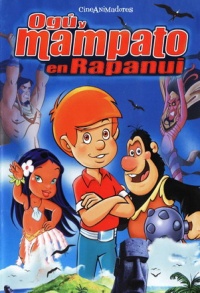Ogu and Mampato in Rapa Nui
| Ogu and Mampato in Rapa Nui | |
|---|---|
 Movie poster for Ogu and Mampato in Rapa Nui | |
| Directed by | Alejandro Rojas |
| Written by | Screenplay and Writer: Original Comic Book: Themo Lobos |
| Starring | Marina Huerta Alondra Hidalgo Mario Castañeda Benjamin Rivera |
| Music by | Joe Vasconcellos |
| Distributed by | |
Release date |
|
Running time | 80 minutes |
| Country | Chile |
| Language | Spanish |
Ogu and Mampato in Rapa Nui (Spanish: Ogú y Mampato en Rapa Nui), also known as Mampato: The Movie (Spanish: Mampato: La Película) is a feature-length Chilean animated film, created by Cine Animadores and executive produced by Elastic Studios, released June 27, 2002. Although the film isn't the first animated feature made in Chile, being the second after Alfredo Serey's 1921 film (The Transmission of Presidential Control), it is considered the country's first "modern" animated film.[1] The movie is based on the Chilean comics character created in 1971 for the magazine of the same name by Themo Lobos and Eduardo Armstrong, and later reprinted as the comic-book Cucalón, the story for the film being adapted from the seventh adventure in the series: "Mata-ki-te-rangui".
Plot[]
Excited by the stories he knows about Easter Island, Mampato, a young boy with a belt device that allows time-travel, goes with his caveman friend Ogú to the ancient land of pre-columbian Rapa Nui. There they meet a little girl named Marama and discover the old traditions of the natives.
Involuntarily, the protagonists get involved in the conflicts and rivalries of the island's inhabitants, where the ariki people subjugate the Orejas Cortas, Marama's tribe.
Production[]
Mampato is, with Condorito, the most popular and acclaimed comic strip from Chile. Cine Animadores, an emerging animation studio, chose Mampato to be made into the first feature-length animated film in Chilean history since the 1920s. Starting production in 1999, director Alejandro Rojas made a treatment with Themo Lobos and selected the seventh story rather than the first one, because it was based on Easter Island, a world-renowned location (with its famous Moais) best suited for a strong Latin American advertising campaign and as a means to generate non-Chilean interest.
Although the film was completely produced and animated in Chile, the voice acting was made in Mexico with recognizable voice actors like Mario Castañeda and Alondra Hidalgo. This was an attempt to achieve a neutral Spanish accent, but the choice was criticized in Chile for it reduced the Chilean feel of the original material (although the Mexican voice actors did get to say some Chilean Spanish slang words).
Reception[]
The film got very good to decent reviews by critics[citation needed] and was Chile's submission to the Academy Award for Best Foreign Language Film in 2002.
See also[]
- List of Chilean submissions for the Academy Award for Best Foreign Language Film
- List of submissions to the 75th Academy Awards for Best Foreign Language Film
- Papelucho and the Martian: The second Cine Animadores film, based on Papelucho books.
References[]
- ^ Rafael Valle. "Ogú y Mampato en Rapa Nui review by Mabuse e-zine". Archived from the original on 26 June 2008. Retrieved 23 December 2008.
External links[]
- 2002 films
- Spanish-language films
- 2002 animated films
- Chilean films
- Chilean animated films
- Chilean science fiction films
- Animated films based on comics
- Films set in Easter Island
- Films set on islands
- Films about time travel